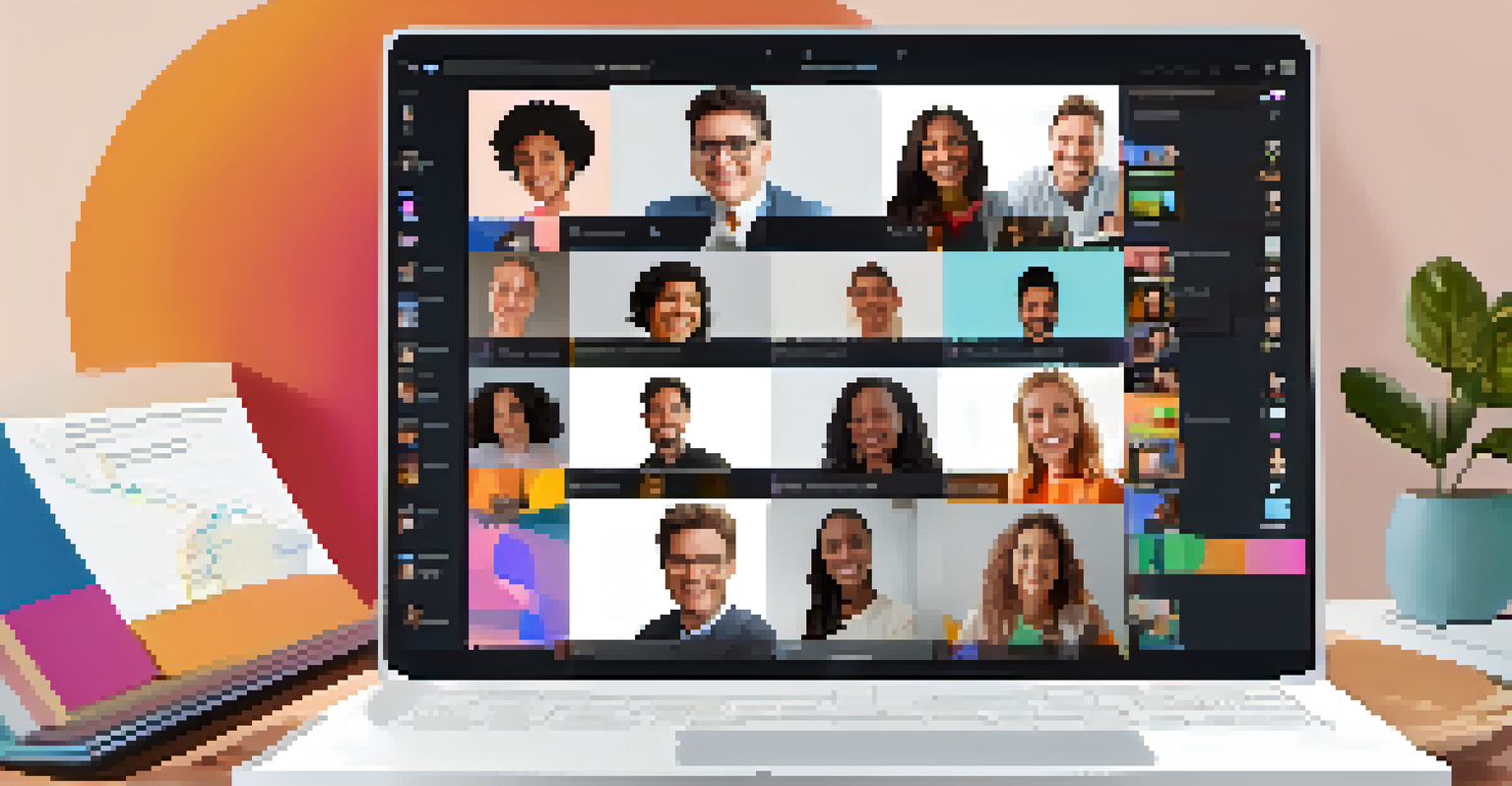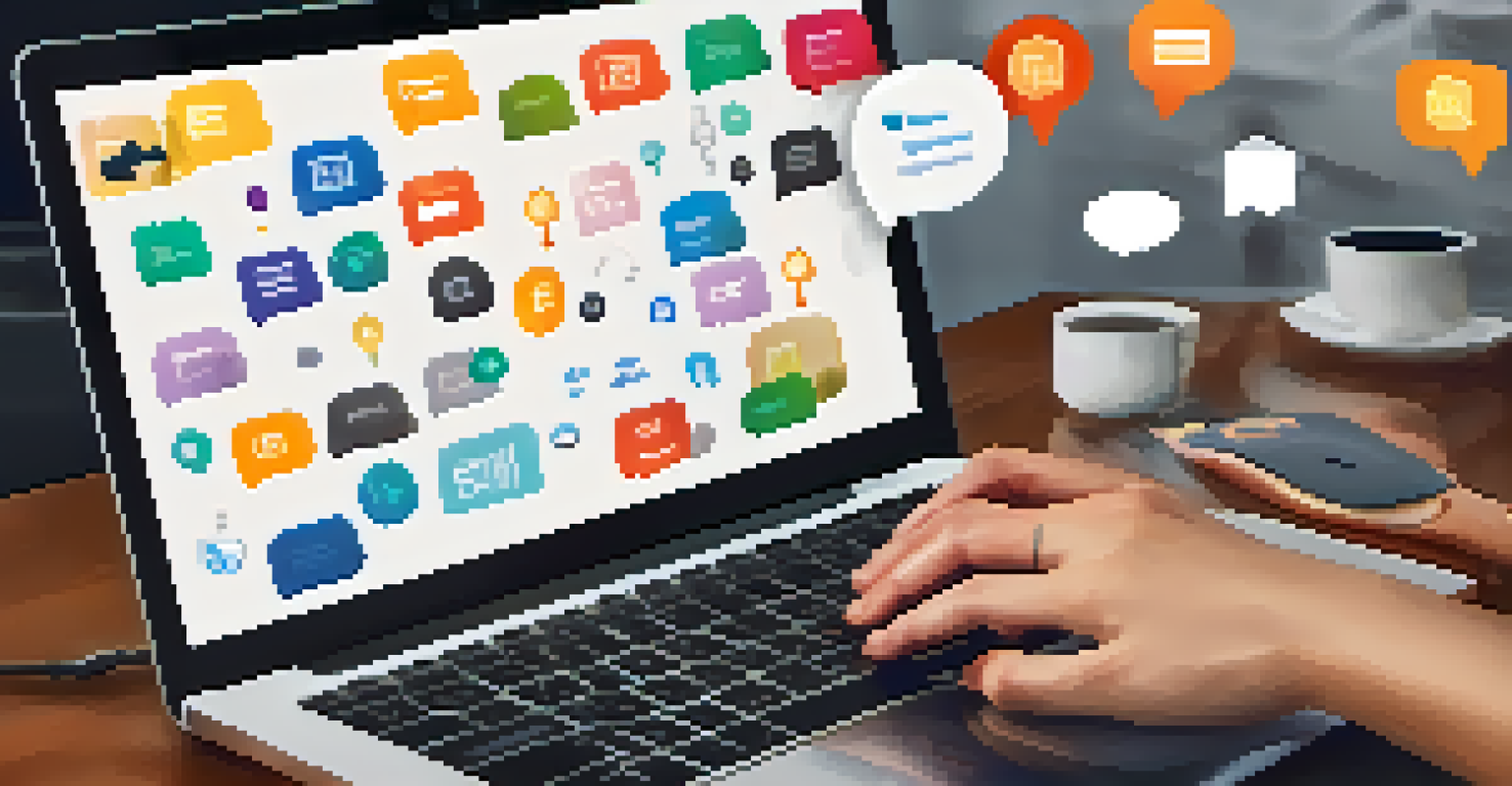Using Collaboration Tools to Foster Team Creativity

Understanding Collaboration Tools for Teams
Collaboration tools are digital platforms designed to help teams work together efficiently. Think of them as virtual meeting rooms where ideas can flow freely, no matter where team members are located. From project management software to communication apps, these tools create an environment that encourages creativity and innovation.
Alone we can do so little; together we can do so much.
By using collaboration tools, teams can share resources, brainstorm, and provide feedback in real time. This instant connectivity allows for a dynamic exchange of ideas that might not happen in traditional settings. It's like having a whiteboard where everyone can contribute, regardless of their physical location.
Ultimately, these tools help break down barriers and foster a culture of open communication. When team members feel comfortable sharing their thoughts, creativity flourishes, leading to more innovative solutions and a stronger team dynamic.
Creating a Safe Space for Idea Sharing
One of the biggest hurdles in fostering creativity is ensuring that everyone feels comfortable sharing their ideas. Collaboration tools can help create a safe space where team members can express their thoughts without fear of judgment. Features like anonymous feedback or suggestion boxes can encourage even the shyest individuals to contribute.

When team members know their voices are valued, they’re more likely to share unconventional ideas and think outside the box. This is crucial because some of the best innovations come from unexpected places. Just like a brainstorming session, where every idea is worth exploring, collaboration tools can replicate that environment digitally.
Collaboration Tools Enhance Creativity
Digital collaboration tools facilitate idea sharing and foster an environment for innovation among team members.
Moreover, when diverse perspectives are encouraged, the potential for creativity multiplies. Different backgrounds and experiences lead to unique ideas, which can be the spark for groundbreaking projects.
Utilizing Brainstorming Features Effectively
Many collaboration tools come equipped with brainstorming features designed to enhance creativity. These tools allow team members to share ideas in a structured yet flexible manner, similar to a digital brainstorming session. Utilizing these features can lead to a wealth of ideas that can be further refined and developed.
Great things in business are never done by one person; they're done by a team of people.
For example, tools like Miro or Trello enable teams to create mind maps or visual boards to organize thoughts visually. This can help clarify complex ideas and make them more accessible to everyone involved. When ideas are presented visually, it often sparks additional thoughts and connections.
Incorporating brainstorming features not only boosts creativity but also encourages participation from every team member. This democratic approach to idea generation can lead to innovative solutions that might have remained undiscovered in a more traditional setting.
Fostering Collaboration Through Communication Tools
Effective communication is the backbone of any creative team. Collaboration tools that focus on communication, like Slack or Microsoft Teams, enable real-time discussions, making it easy to bounce ideas off one another. This immediacy can lead to spontaneous brainstorming sessions that generate fresh concepts.
Furthermore, these tools often include integrations with other platforms, allowing teams to pull in relevant data or resources during discussions. For instance, sharing a document or linking to a research article can inspire new thoughts and refine existing ideas. It’s like having a library and a cafe in one space—resources are at your fingertips while you engage in lively conversation.
Feedback Fuels Creative Growth
Regular feedback through collaboration platforms allows teams to refine ideas and encourages bolder contributions.
By fostering an environment of open communication, collaboration tools help keep creativity flowing. When team members can easily connect and share ideas, they’re more likely to collaborate effectively and develop innovative solutions.
Encouraging Feedback and Iteration
Feedback is vital in the creative process, and collaboration tools can facilitate this crucial component. By using platforms that allow for easy commenting and suggestions, teams can iterate on ideas quickly. This agile approach ensures that concepts are continuously refined and improved upon, leading to more polished outcomes.
For example, tools like Google Docs allow multiple users to comment on a document simultaneously, making it easy for everyone to weigh in. This open feedback loop encourages collaboration and fosters an environment where ideas can evolve organically. It’s similar to a sculptor chipping away at a block of marble until the final form emerges.
Additionally, regular feedback helps build trust among team members. When individuals see their contributions being valued and integrated into projects, it encourages them to take more risks and be bolder in their creativity.
Balancing Structure and Flexibility
While collaboration tools are essential for fostering creativity, it’s crucial to find a balance between structure and flexibility. Too much rigidity can stifle innovation, while complete chaos can lead to miscommunication. The best approach is to establish clear guidelines while allowing room for spontaneous creativity.
For instance, using project management tools to set deadlines and expectations can provide a framework within which creativity can thrive. At the same time, allowing for ‘free time’ where team members can explore ideas without constraints can lead to unexpected breakthroughs. Think of it as a garden with pathways—structure is necessary, but the plants can grow wild within those paths.
Balance Structure with Flexibility
Finding the right mix of guidelines and creative freedom is essential for maximizing productivity and innovation.
Striking the right balance ensures that teams remain productive without sacrificing creativity. This way, they can navigate their projects with both direction and inspiration.
Celebrating Creative Achievements Together
Celebrating successes, big or small, is essential for maintaining a creative spirit within a team. Collaboration tools can help recognize and showcase achievements, reinforcing a culture of appreciation. Whether it’s a shout-out in a team chat or a dedicated channel for sharing wins, acknowledging contributions fosters motivation and team cohesion.
By celebrating creative milestones, teams can reflect on their collective journey and inspire further innovation. It’s similar to a sports team that reviews their highlights after each game; it builds camaraderie and encourages everyone to strive for excellence.

Moreover, these celebrations can also serve as a reminder of what’s possible when creativity flourishes in a collaborative environment. This positive reinforcement can keep the momentum going and encourage more creative endeavors in the future.
Wrapping Up: The Power of Collaboration Tools
In summary, collaboration tools are invaluable for fostering creativity among teams. They create an environment where ideas can flow freely, feedback can be shared easily, and diverse perspectives can be integrated. By leveraging these tools effectively, teams can break down barriers and cultivate a culture that prioritizes innovation.
As we've explored, from brainstorming features to communication tools, the right resources can enhance the creative process. They help teams stay connected and engaged, ensuring that every member feels valued and empowered to contribute.
Ultimately, investing in collaboration tools is investing in the creative potential of your team. Embracing these technologies can lead to groundbreaking ideas and solutions that drive success.